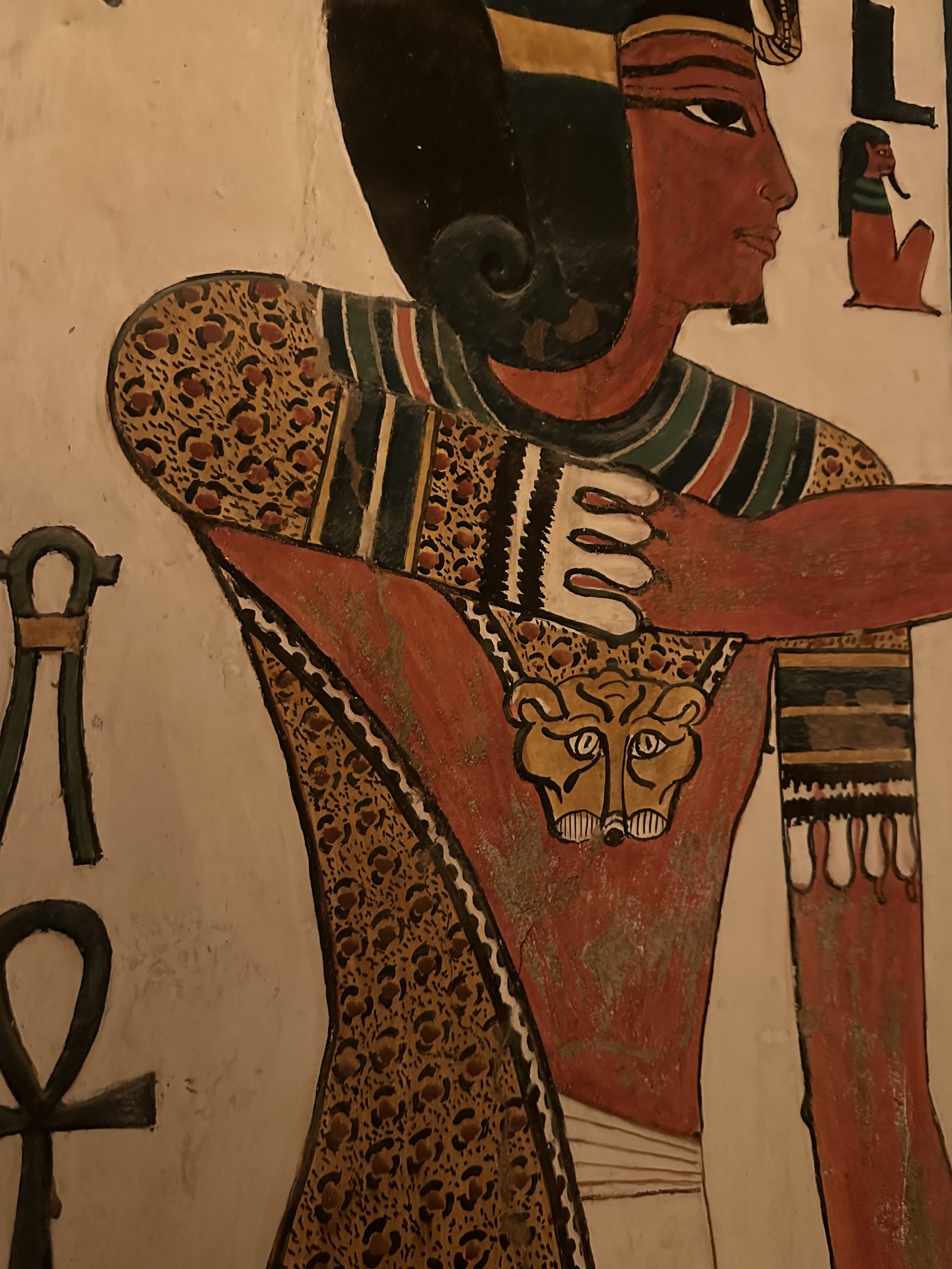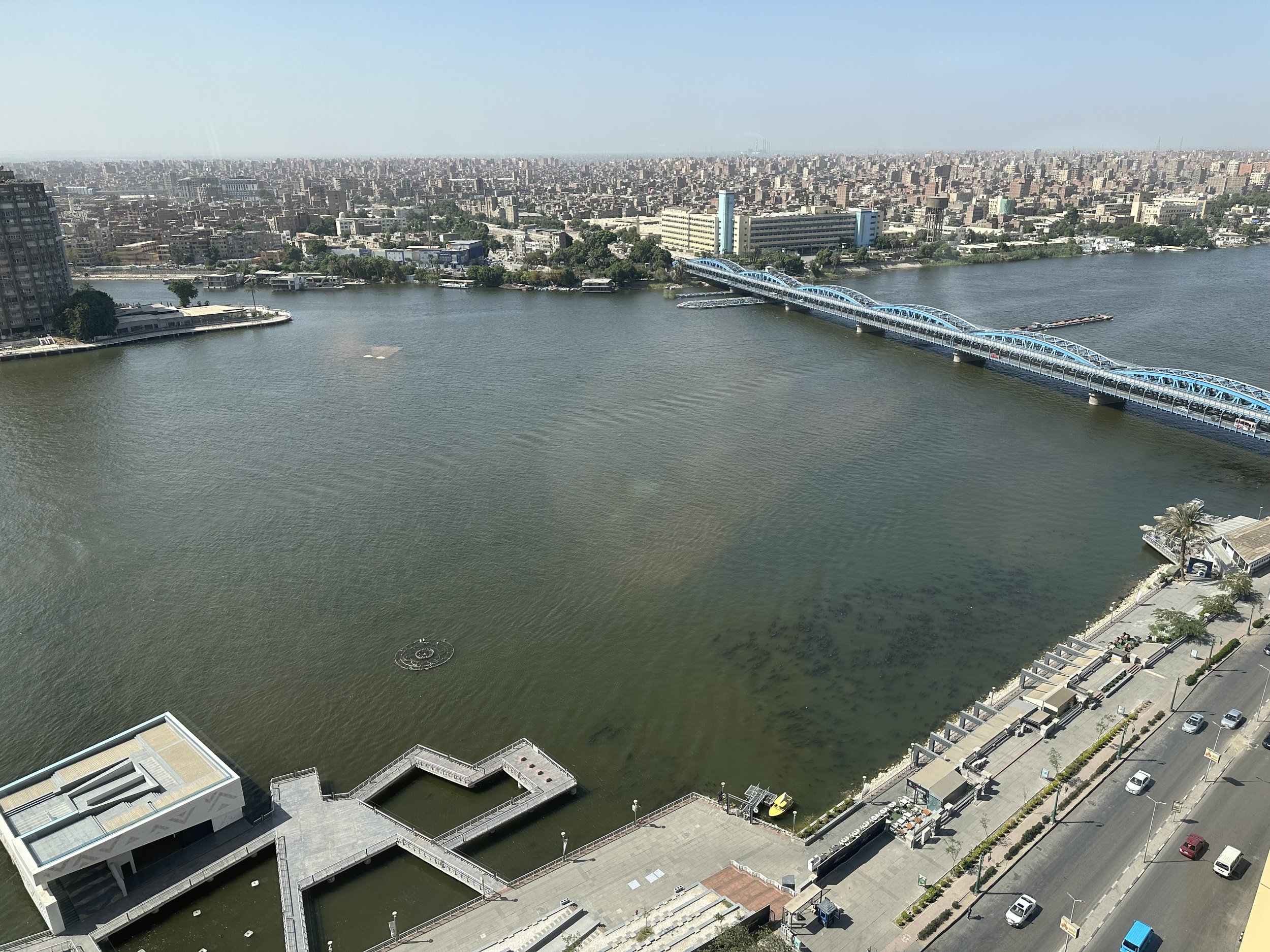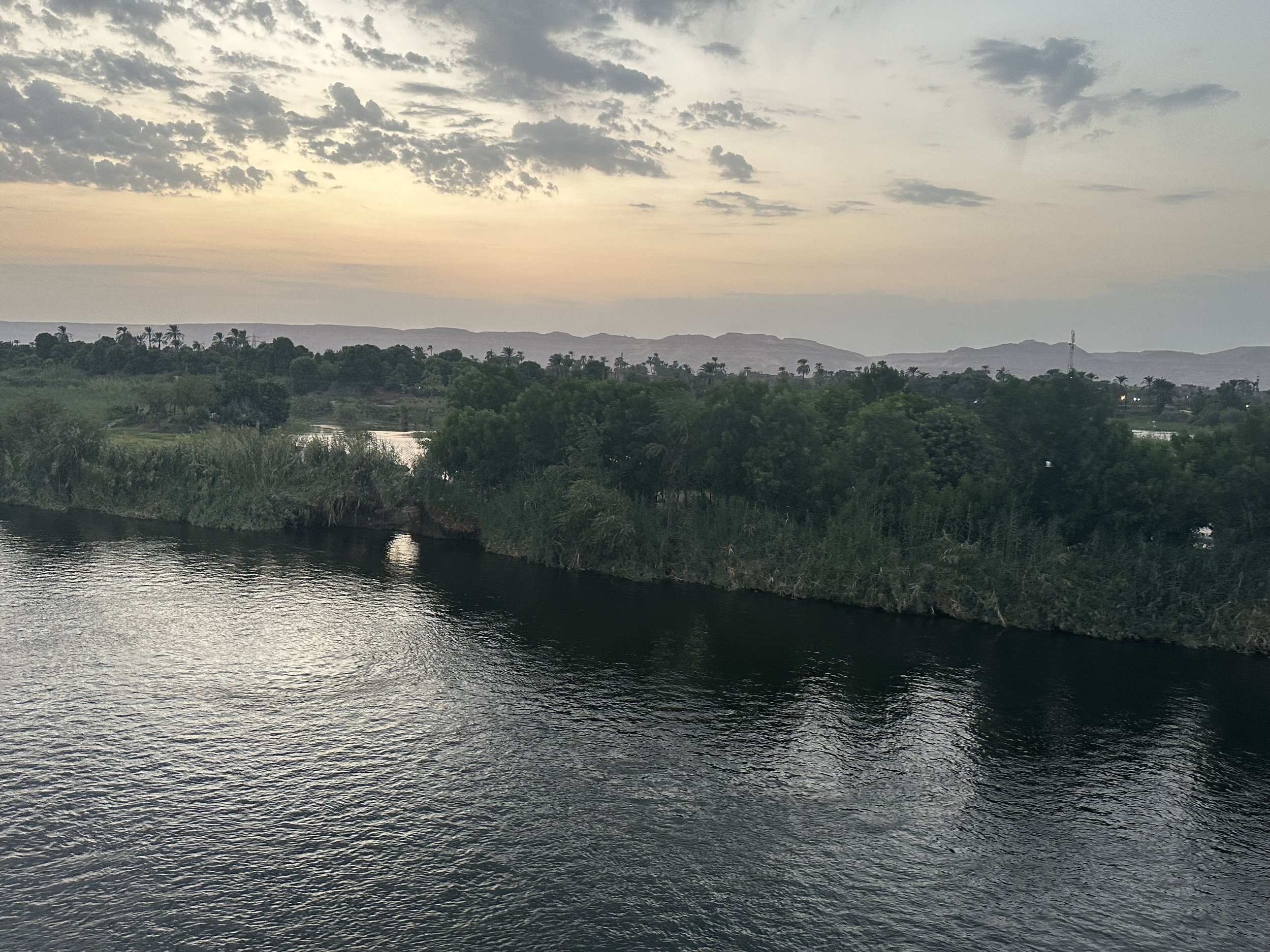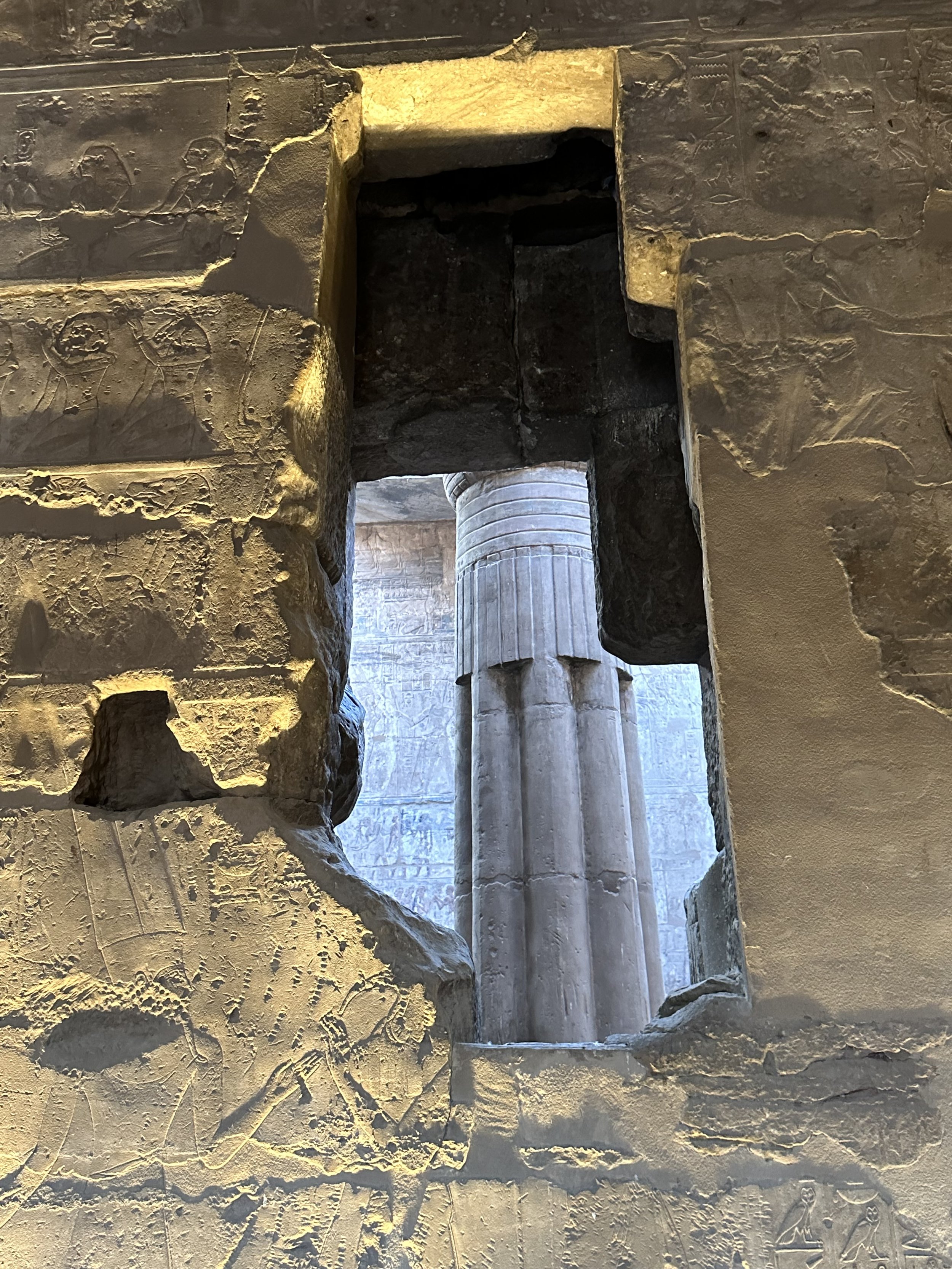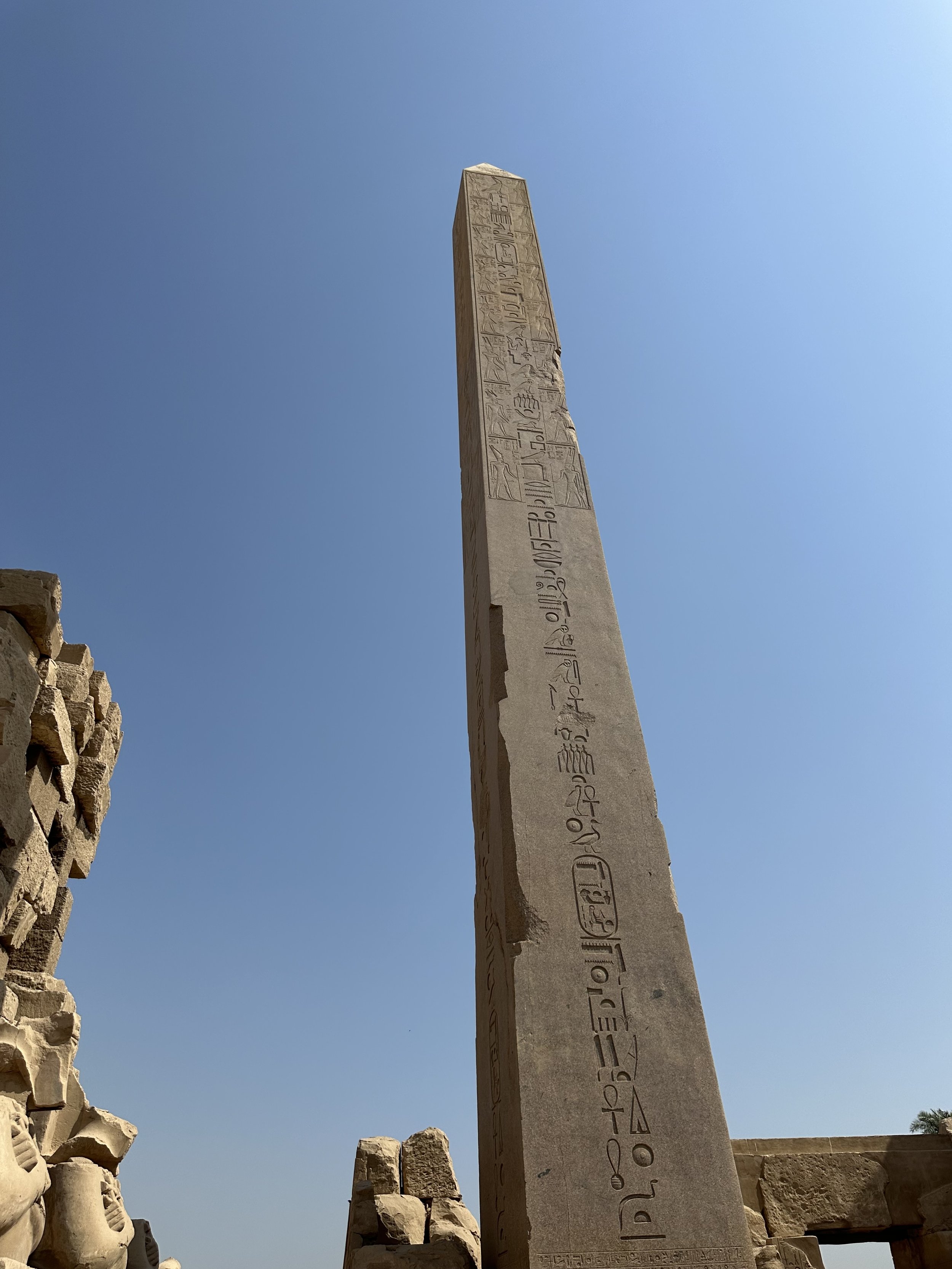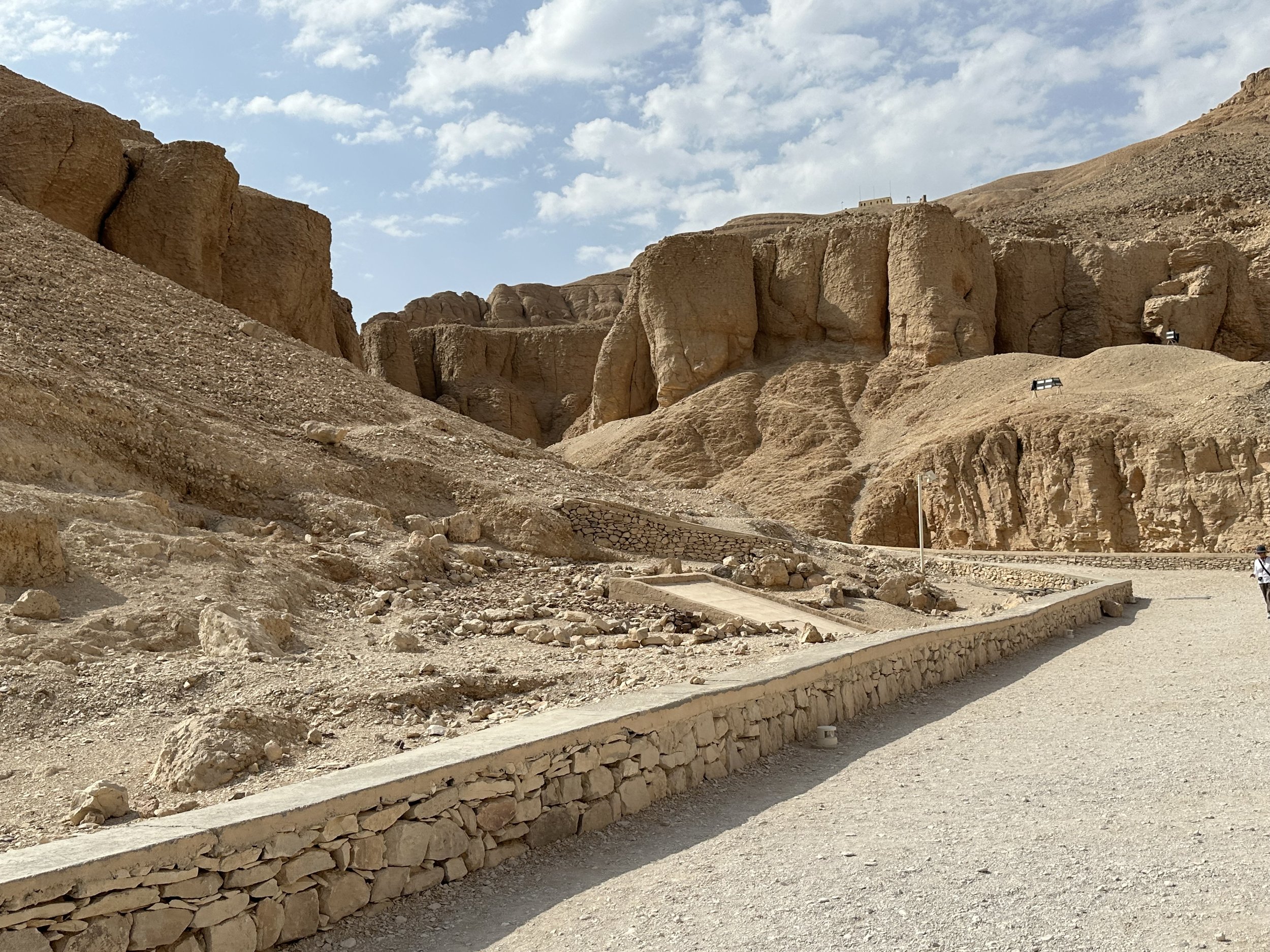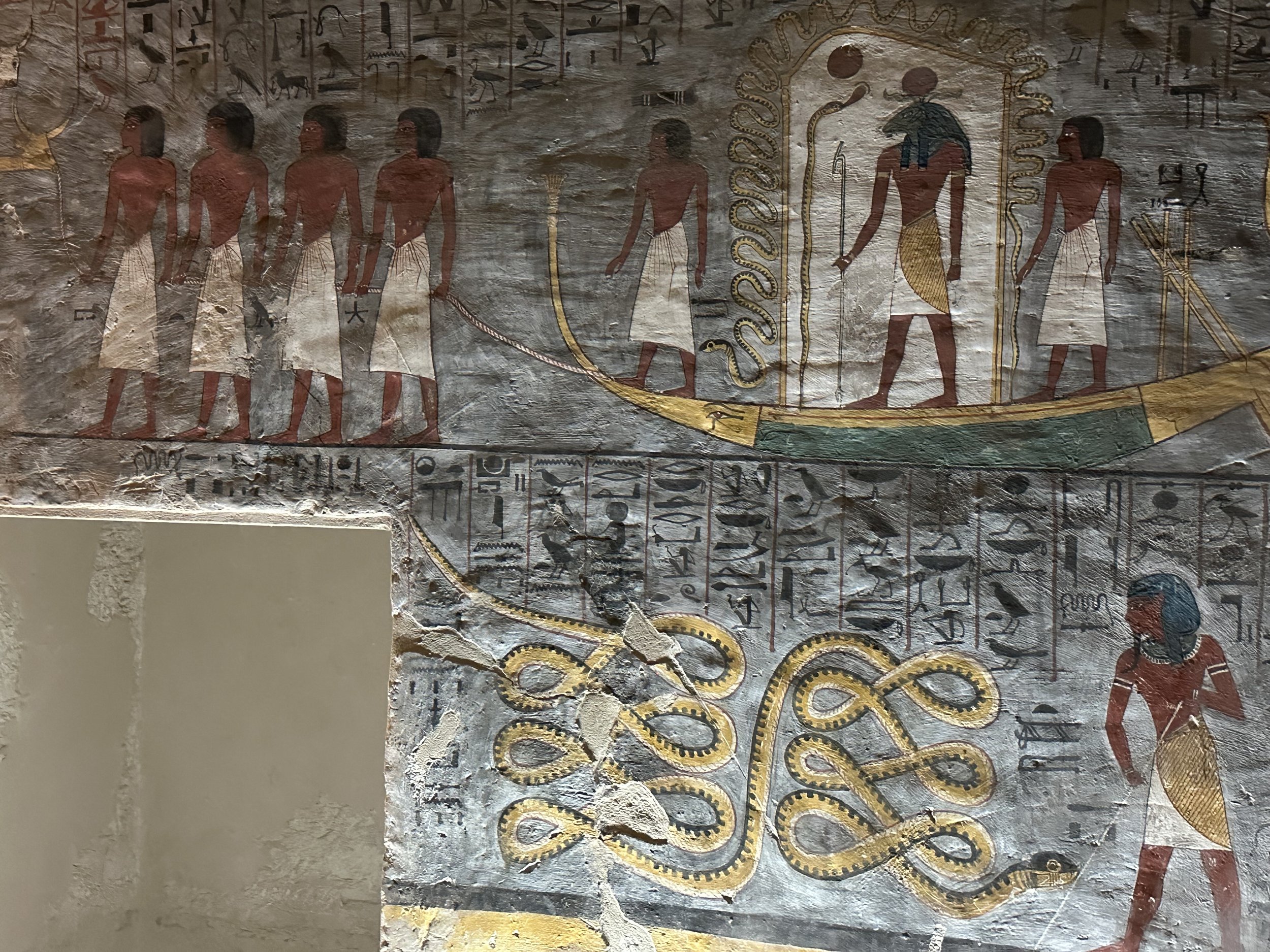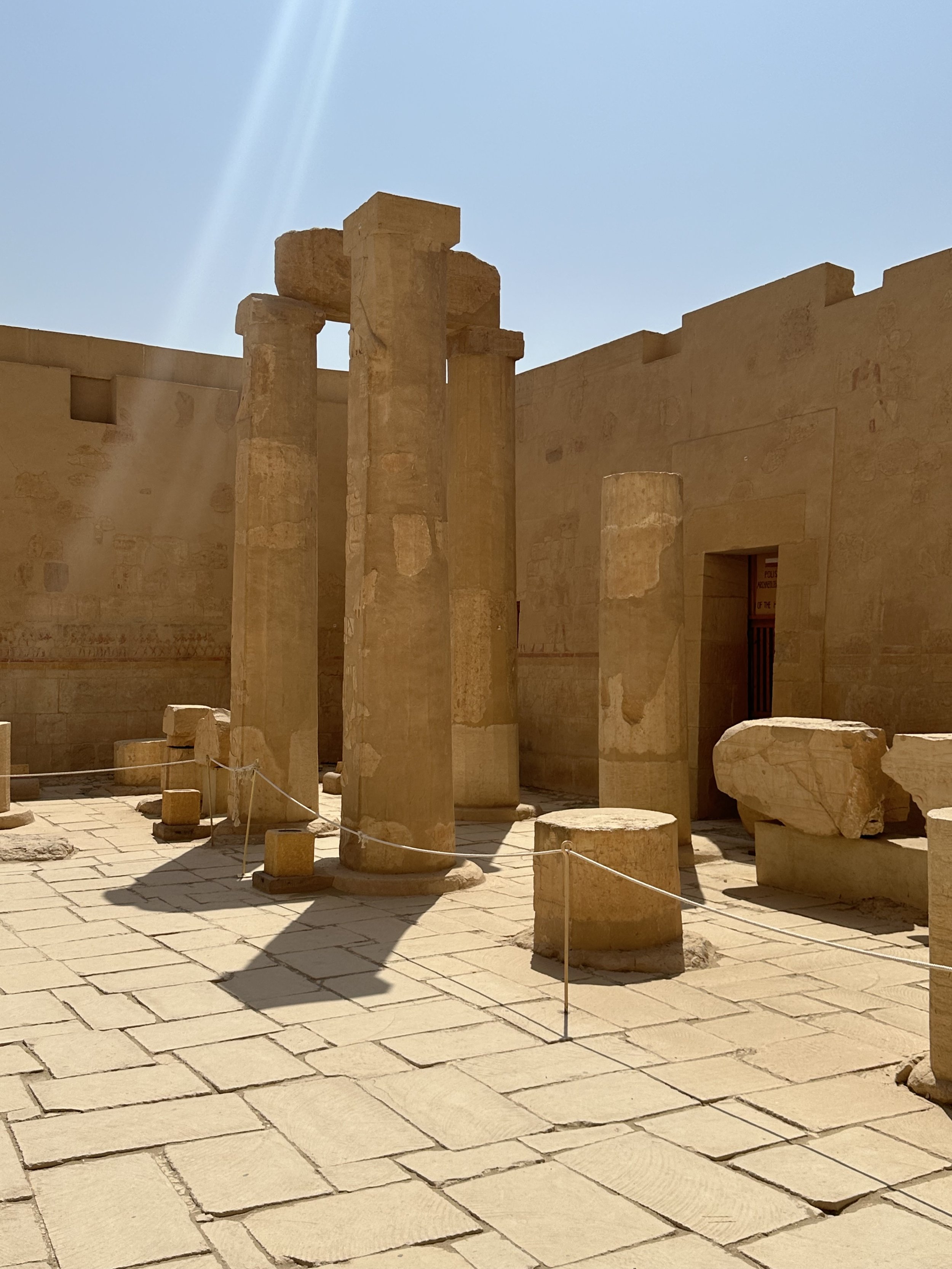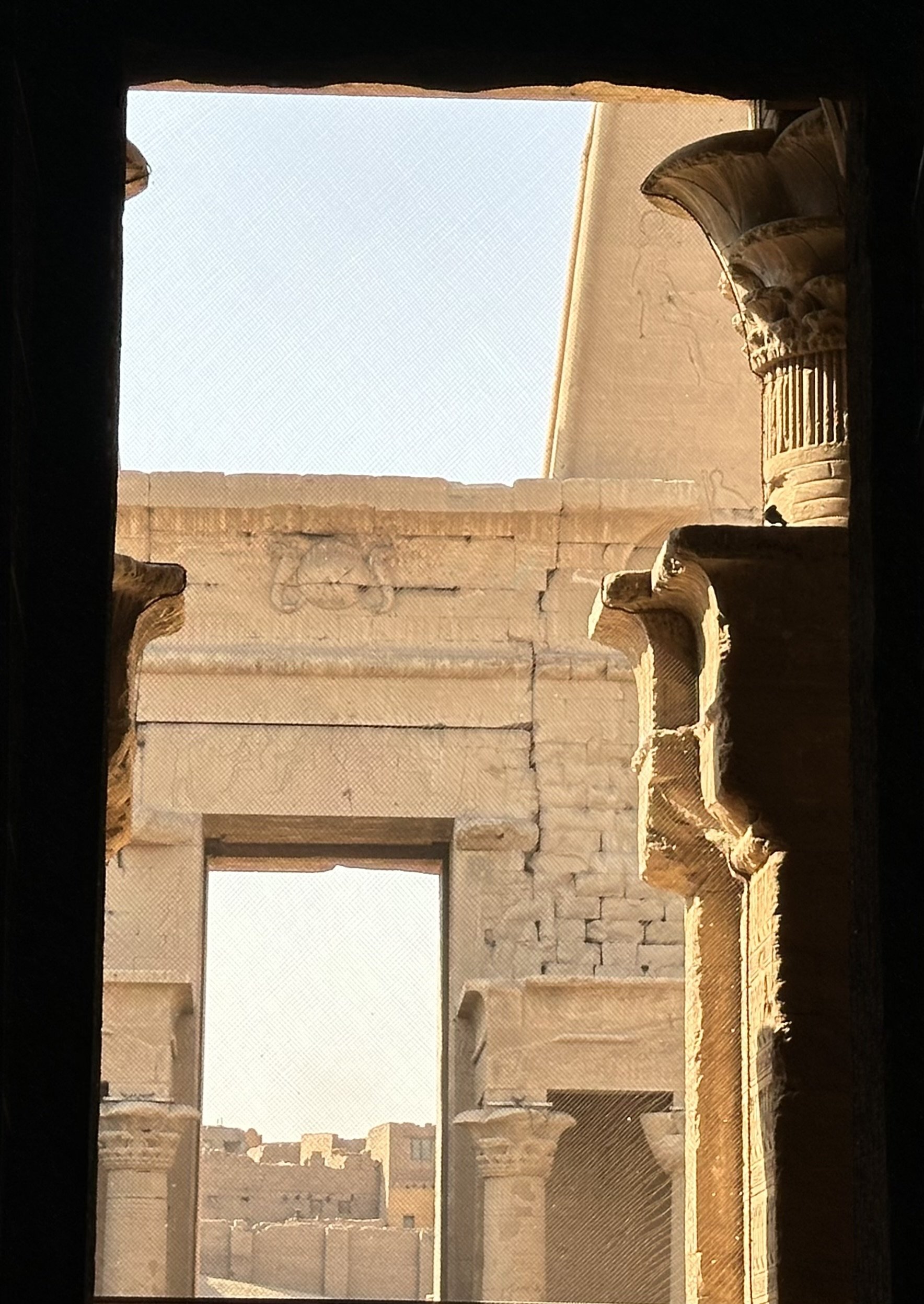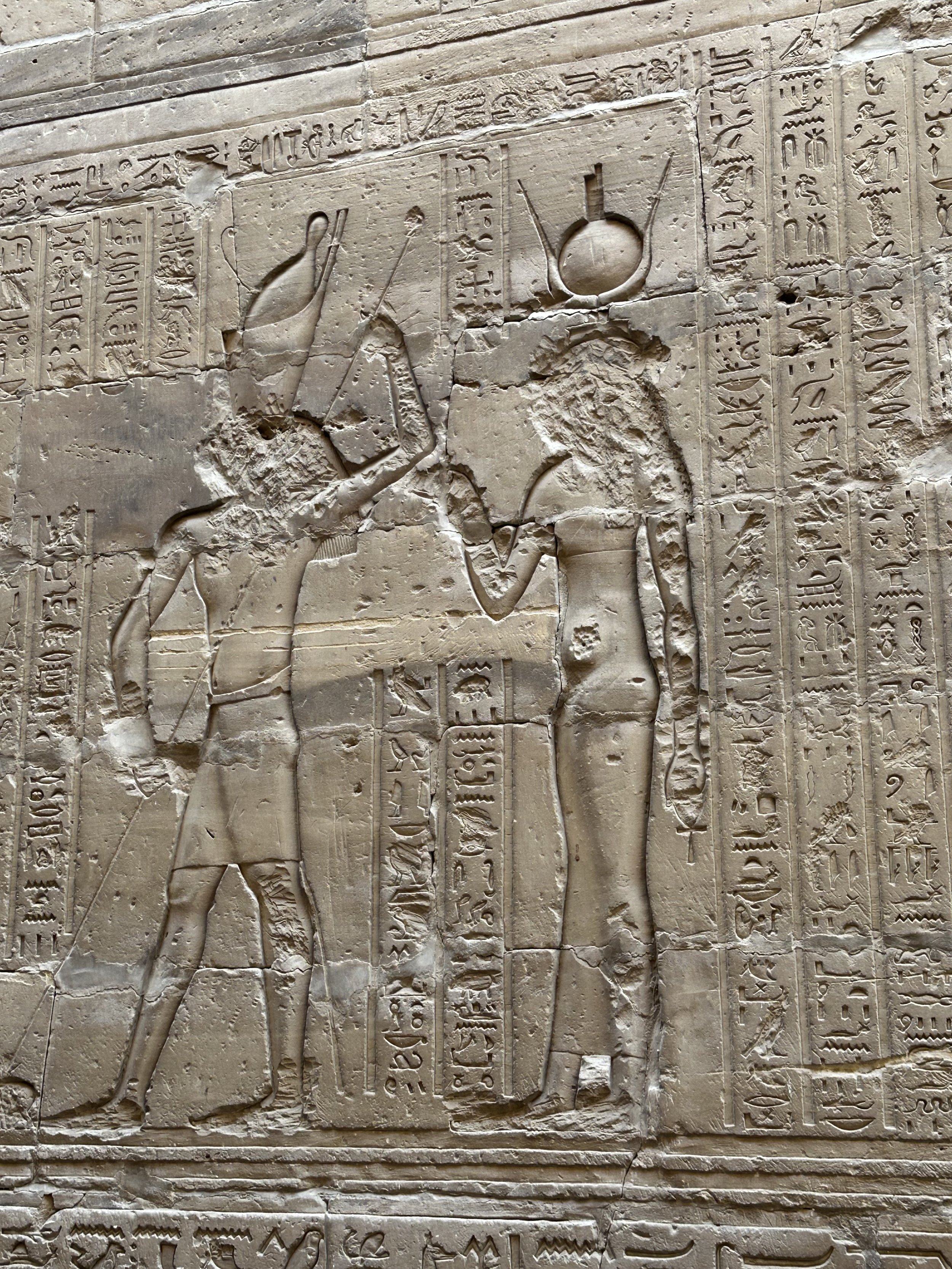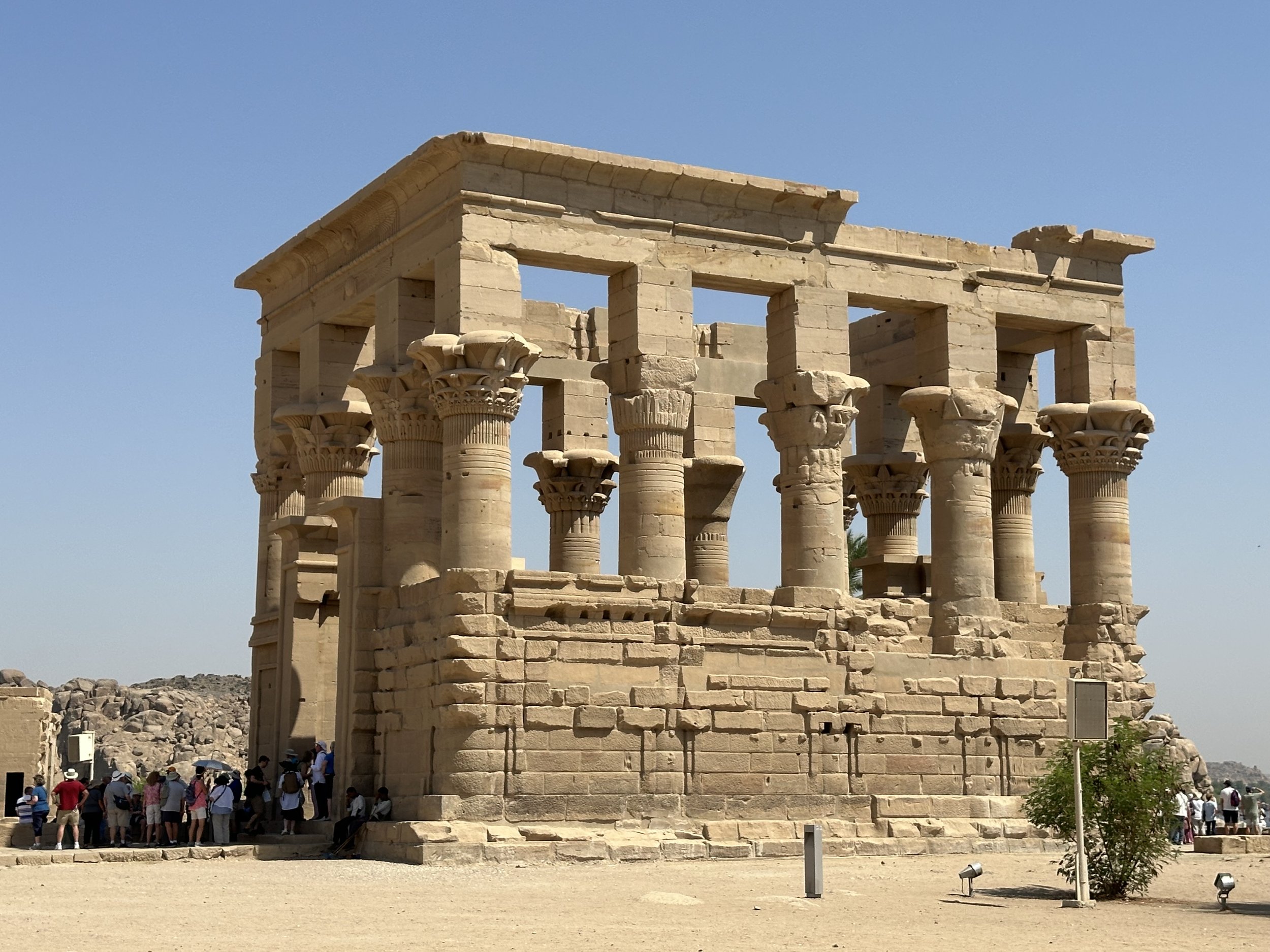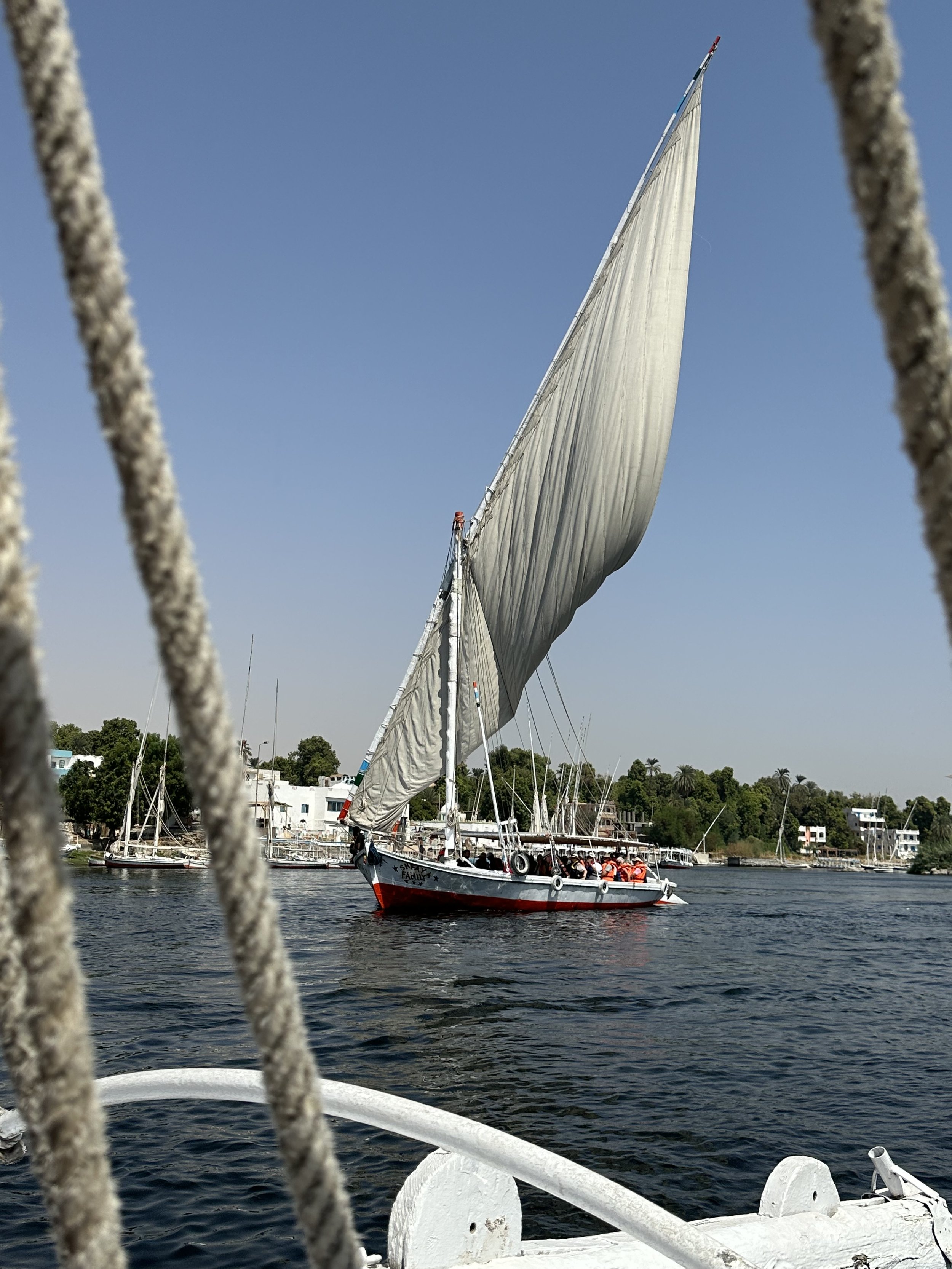Egypt Sept 28, 2023
The Romans and ancient Greeks marveled at the pyramids. They were as old to them then as the Colosseum is to us now. This perspective is a little hard to get your head around. It distorted my sense of what old really is. So while touring Egypt, every time we came upon a site that was only dated to the Ptolemy era or Roman times we tended to loose a little interest. After all we were there to see the “ancient” ruins. How strange it is to see these remnants of such a sophisticated civilization that endured so long (consider ancient Egypt existed as a nation longer than the time past since its fall ). More strange, is how today you can view paintings and sculptures that appear almost as pristine as if they were created just yesterday.
Artwork, not retouched, deep inside Nefertari’s tomb
Traveling to this place is not some comfortable luxury excursion. Even if you take the cushy route like we did via Viking cruise. We were very nervous about traveling to Egypt and so we opted for an escorted journey. Like a little kid put on a plane to see his aunt, we were met at the airport walking out from the gate area and then on our way home were escorted all the way through security. We were never on our own. Not being one who gravitates toward using guides and certainly avoids tour groups, I can’t argue for my logic other than to say anxiety is what it is. Yet looking back I never felt like I should have taken more of a go it alone approach.
The Nile downtown Cairo before it branches into the delta
Apartments under construction
Cairo is major urban sprawl, and driving through the city you pass its modern polished areas and its older third world poverty expanses. Regarding the later there is little concern for the importance of fine architecture and landscaping or shall we say street appeal. Most homes are designed to be nothing more than a place of refuge, and appear to be clinging to the landscape like barnacles on a pier. This approach however is very practical and efficient. You build a reinforced concrete building frame and leave the rebar sticking out of the top for when you need another floor. Then you buy the bricks as you can afford them so when the family grows and you have the materials, you expand. Certainly not the way we approach things, but given the economy and lending practices they face, it makes sense. Like most cities, Cairo has its levels of affluence. There are the really poor, then the working class neighborhoods and of course the wealthy areas with their adjacent and opulent malls and hotels. What it isn’t, is the third world dump you might have been led to believe. Anyway, I think two full days in Cairo is more than plenty. In total, we would wind up spending four there including nearby Giza.
Cairo viewed from the Qala’at Salāh ad-Dīn, Citadel of Saladin
The mosque of Muhamad Ali (the other guy) inside the Citadel of Saladin
Courtyard of the mosque
Inside the mosque of Muhamad Ali
I’m not going to chronicle the trip point to point, I’ll let the photos do that. As an overview I’ll describe the trip as basically having three parts; Cairo, the Nile cruise and the Luxor area. The beginning and end was spent at Cairo. In between we spent our time first seeing Luxor and then moving down the Nile south to Aswan and circling back, stopping at various points along the way. Our tour group was comprised of mostly Americans. Old ones. Funny how I feel a bit uncomfortable being around a bunch of old people moving slowly on and off tour buses, and forget entirely that I fit right in.
At the Egyptian Museum Cairo, this is the oldest Egyptian artwork in existence and celebrates the joining of the upper and lower Nile kingdoms.
The ancient game of Senet displayed at the Egyptian Museum, a precursor of Backgammon
Also at the museum, the sarcophagus of Akhememdon, the father of King Tut and not so well liked. His face and nameplate were removed soon after burial to prevent the gods from finding him and leading him into the afterlife.
It was the shoulder season, and yet it was so hot. Not Chicago hot, not Arizona hot, like Venus hot. Most days were over 110 degrees and the sun was brutal. I usually try and wear a hat if I’m outside in the sun for awhile and certainly sun screen. In Egypt, if you leave home without your hat you might as well have forgotten your pants. You cover up and scramble around looking for one. I routinely found myself walking a longer path, just to spend as much time as I could in the shade.
In front of the Djoser step pyramid, one of Egypt earliest attempts at the structures. Located at the Saqqara burial grounds just south of Giza.
Saqqara, just south of Giza
The art inside
The Great Pyramids of Giza
He doesn’t look happy to see me
There are sphinx everywhere in ancient Egypt, this obviously being the largest, perhaps the most weathered and worn.
The backdrop of nearby Cairo
Some perspective on the size of the stone blocks. At the base you can see the white limestone that once smoothly covered the exterior and shimmered in the sun. Most was long since stripped for building materials
After leaving Cairo we flew south to Luxor to board the ship. Our voyage would make its way south to the Aswan dam and back, and take most of the week. Like visiting castles or cathedrals in Europe, after a while the magnificence of the Egyptian temples and colossal works start to run together. They share a style that is both beautiful, and moving; yet after a while the sights seems to saturate you, making it hard remember what you saw where. There were a couple places that really stood out, and I’ll try and describe them in more detail. But before I do that, I want to touch on the experience of cruising the Nile.
The Nile
Between landscape paintings, old epic DeMile movies and museum displays you form an impression of this noble river. I fully expected to be disappointed. I was sure now it was smelly, cluttered with plastic and garbage like Chao Phraya River in Bangkok and busy with noisy barge traffic. It was none of that. The grand river was enchanting, at least the sections we traveled. I just enjoyed looking around as we passed by, watching the small boats go by and gazing at the weedy banks. Certainly nowhere in the world, at least that I can think of, does a river play such a prominent role in peoples lives, and it has for millennium. Egypt may be a big square on the map, but in reality it is all no more than a river and its banks. That’s it. The rest is desert. The greenery and farmland that runs along those banks at times is so narrow you can see the desert beyond from your boat.
Our River Boat
It’s a short flight to Luxor. Access on and off the boat was easy, it was small but comfortable and modern. The cruise began here with a tour of Luxor Temple and the Karnak Temple complex. Luxor or in ancient times Thebes, is situated on the east bank of the Nile and was once the heart of Egypt. At first the kingdom was centered at Memphis just south of Cairo and Giza, but later dynasties would move and build here.. Following the path of the sun and its parallel to life, the east side is where the population lived and the west bank was where it was buried. So the valley of the kings, like the pyramids are located on the west bank. The ruins around Thebes and its temple grounds are massive and we spent a good part and the best part of the trip there.
The Luxor Temple entrance. There were two of these 3000 year old obelisks, the one to the right of the entry was removed by the French and now stands in Paris at the Pace de la Concorde.
Luxor Temple and its colossal statues
Luxor Temple is striking, standing next to the Nile. Nearly lost, it was once covered in sand.
Inside the many still enclosed rooms of the Luxor temple
The Avenue of the Sphinxes stretches nearly two kilometers from Luxor Temple north to the Al Karnak temples. This is looking north toward Al Karnak.
The avenue was used for ceremonial processions including this piece which is a recreation
View to the Nile from Luxor Temple at sunset
On the living side of the Nile at Luxor, the two large temple complexes dominate the historical landscape. Luxor Temple to the south and the even larger grounds of Al Karnak temples north, joined by the Avenue of the Sphinxes. The various temples are surrounded by long open corridors and squares that are adorned with endless columns and statues. The various obelisks now seem randomly placed but that’s probably due to most (likely the best preserved) being pilfered by European powers over the centuries.
An obelisk at Al Karnak
Sphinx everywhere
Entrance to Al Karnak
Al Karnak
The Sacred Lake at Al Karnak
The Valley of the Kings and the nearby Valley of the Queens lies across the Nile from Luxor on the western bank and under the setting sun. We toured both. You are limited as to how many tombs you can tour on a ticket by park rules. The tombs are spread out and connected by dusty trails. The long ramp down into the small rooms is sometimes a bit tight. Some of the tombs are more extravagant, some more modest. Of course staying hidden and protected was paramount and only a few made the journey through time unmolested. The artworks and overall condition of the tombs longest hidden are magnificent. I made my way through as many as I could. Some you could nearly walk right in, others had lines.
Candy is in one of these balloons hovering over the Valley of the Kings at dawn
Valley of the Kings
Roads and paths through the valley lead to the tombs.
Inside Tut’s tomb, which is just a few rooms and rather small for his importance. Most of the artifacts and treasures from the tomb are in Cairo.
For now, Tut is under glass, still in his tomb. You would expect he’ll be moved to Cairo’s museums in the future.
Nefratari’s tomb is one of the most beautiful and best preserved. Remember Ann Baxter playing her in the Ten Commandments?
Situated between the valleys, and built back into the massive cliffs that surround it, lies the Hatshepsut Temple. Pharaoh Hatshepsut was not as famous as the well known queens Nefertiti or Cleopatra, yet she was one of Eqypt’s greatest rulers. Under her reign Egypt enjoyed a period of peace and prospertity, expanding trade and taking on some of it’s greatest building projects including Karnak. Hatshepsut managed to thrive in the male dominated world by characterizing herself in monuments and art as a male. Upon her death much of sculptures and depictions were destroyed by her successors who no doubt resented her gender. The Temple is acutally a mortuary and was built near her tomb to allow ongoing sacrifice to preserve her soul in the afterlife. The temple site was the scene of a terrorist attack in 1997 that killed 62 people, nearly all European tourists. The attack was particularly lethal due to how the temple area is situated which allows almost no escape. After this tragedy, the tourism business was nearly ruined for decades only reviving recently to be again diminished during covid. Today throughout Egypt’s great tourist sites there is extensive military presence and a clear indication that the Egyptians are going to go to great lengths to protect their tourist industry.
The cruise continued south to the Aswan dam, stopping on the way at various points along the shore and at islands for short tours. Given that the country is built around the Nile river, the Aswan dam construction had a massive impact on the lives of Egyptians. Control of the Nile floods protected their homes, stabilized harvests and provided energy. The original or low dam, was built by the British at the turn of the prior century. It was in the 1960’s that Egypt’s president Nassar realized the need for a much bigger and higher dam. First the American’s offered help but the deal fell through and it was the Soviet Union that financed the new dam which was completed in 1976. In the process, thousands of Nubian families were relocated, as were ancient historical sites. One of the major relocation projects was the Temple Philae complex, which was moved in its entirety to high ground on the isle of Agilkia in the middle of the Aswan reservoir.
Dendara Temple Complex
Dendera
Dendara
Dendara
The temple at Edfu
Edfu
Edfu
Edfu
Candy poses with Horus, the falcon god.
Notice the faces and hands have benn chipped away. This was very common at some temples and I was told that over time other religions found the depictions offensive and vandalized them.
Agilkia Isand and the Philae Temples
Philae Temple
At Aswan we took a smaller craft along the Nile to the top of the dam, then another into the southern reservoir to the visit the Philae Temple. On the way back to our boat we made a stop at the Aswan market for local shopping. A final stop was at a Nubian village, which was manicured and configured for the tourist economy but still had a charm and gave a look at life in what was once Egypt’s southern gate.
Young boys would paddle to catch up with our small sailing boat as we approached Aswan. Some sang songs others offered small gifts for whatever coins were available.
An old building used to raise water from the Nile.
This tired doggie is gazing north up the Nile from the top of the dam.
The Aswan Market
Got to sample the local coffee brew.
Aswan Market
Approaching the colorful Nubian Village
A tourist market in the village
The terrace of the new National Museum of Egyptian Civilization in Cairo
After disembarking our cruise where we started, we took a flight back to Cairo. There we toured the National Museum of Egyptian Civilization. The museum is brand new and still being furnished with treasures. Already it is home to nearly every important mummy ever recovered and they are in magnificent condition displayed carefully in a series of connected rooms. Their hair, teeth, skin and even in some cases wounds are eerily well preserved. Unfortunately no pictures were allowed.
On a final note, the day our trip concluded was October 8th. From the day before we began learning of the attacks in Israel. Sunday morning we knew it was bad, but wouldn’t understand the scope of the atrocity until we got home. Some of the guests on our cruise were leaving on flights that day to Tel Aviv and on to Jordan. No one seemed to be hesitating at least at that point. I for one was glad to be flying direct back to Rome. Having traveled to Israel the year prior we were reminded of just how quickly a destination can turn ugly. I guess you need to see what’s on your list as soon as you can. Things change.

